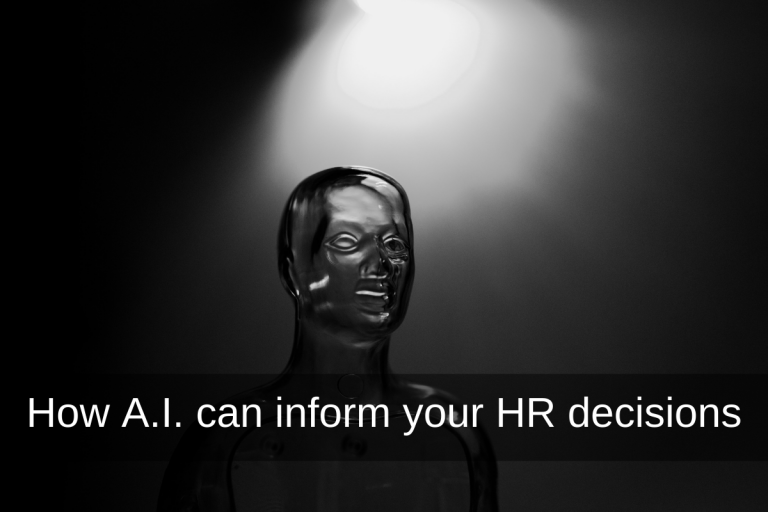There are many positive aspects to how AI can inform your HR decisions but there are also some issues to bear in mind, especially if you want to reduce the risk of grievances.
Artificial Intelligence is growing as a tool for HR in the workplace. Already AI is filtering job applications and used for decisions about deployment and redundancies.
Unconscious Bias
Artificial intelligence can be a positive influence on our unconscious bias at work. As humans, we like to think we make nice rational decisions based on logic.
However, our brains are wired to make decisions at speed. We make around 35,000 decisions every day. If we had to think rationally about every one of these choices, we wouldn’t achieve much. So our brains take over. They use instinct to tell us whether to choose left or right. Tick a box or leave it blank.
We don’t need to engage parts of our brain to do this because it takes up lots of energy. In fact, our brain works with two sides. One is the subconscious part that makes these instant decisions and conserves energy. The other side is our logical, thoughtful functioning side. To do this, we need energy and concentration.
Our subconscious brain is the part that holds our unconscious biases. And the problem here is that we don’t know we have them. We don’t realise our brains are not making rational and logical decisions on our behalf.
Remember when learning to drive, you need to concentrate on which foot goes to which pedal and when. As you learn something new, your brain uses its logical side. It takes up lots of energy. When you’ve been driving awhile, you no longer need to think about those actions. Your brain does it for you.
It’s why you can sometimes end up arriving at a destination having not thought about getting there.
AI and HR decisions
When making HR decisions, we like to think we are using the logical side of our brain but often our subconscious side takes over. We can read a CV or report and we’ve already made a number of decisions before we’ve started our logical thinking.
And this is where AI comes in. Artificial Intelligence only works on the basis of the algorithm. The coding that it uses to help deliver the best possible outcome. Which sounds great when it comes to weeding out those unconscious biases that may impact our decision-making skills. When we make decisions, we bring in our experiences, values and culture whether we realise it or not.
Artificial intelligence on the surface doesn’t have those influences.
However, it is not quite so straightforward. A 2019 study finds that Google Translate carries a gender bias across all languages, regardless of whether or not that particular language has gendered words. Moreover, when it came to jobs, it found that certain roles were considered either masculine or feminine.
There is further research into the biases coded into artificial intelligence and machine learning which finds that only 22% of AI and data science professionals are women. The result is that those who code artificial intelligence and machine learning are in turn coding in their own biases which HR need to be aware of. It is also why relying solely on AI to inform HR decisions is problematic.
Let’s explore this further in some HR processes.
Hiring Process
AI is already used in the hiring process. Tools are used to scan CVs and cover letters for keywords and experience related to the job description. It means that sifting through piles of applications is reduced to only those who seem right for the job on paper.
The positive impact of this is that cues such as a person’s name or where they went to school should not be influencing the outcomes of the data. However, as we can see from studies, AI is not immune to biases within language.
Blind recruitment is not new in HR. The Boston Symphony Orchestra had its first blind recruitment in 1952. What they found was they were still hiring men over women for the orchestra. Until they asked performers to remove their shoes. The sound of the performer walking on stage was giving a clue to the Orchestra as to whether the performer was a man or woman. When the shoes were removed, they found more women were hired.
Likewise, when a hiring manager scans a CV, they are making subconscious assumptions about the applicant from their name, schooling and even the language used.
So using AI to filter CVs seems to be the answer to an unconscious bias in hiring. Yet, this system may not always see whether the potential employee has the soft skills needed to thrive in the team. A person’s ability to succeed in a new position comes down to how well they fit into the team culture. And that is something that cannot be seen through the lens of artificial intelligence.
Redundancy Process
The redundancy process can also be supported with AI. This is often a much harder decision-making event as people being made redundant have often been part of the company for some time and there are emotional elements at play.
Managers will have people in their team who they get along with more than others. They will have personality clashes and further emotional ties to employees which can affect the decision-making process.
Removing the emotion from the redundancy process can have a positive impact. Decisions about redundancy need to be made on the basis of the job roles no longer being necessary for the business. And the decisions need to be made fairly to avoid the risk of future claims.
So engaging artificial intelligence to remove some of the human elements to the redundancy process is a positive move. However, employers should not rely solely on AI for this.
You need to still have people involved in the process. AI can only go so far and cannot see the bigger picture of what the business needs may be in the future. Moreover, AI may only look at the job roles within the company when bringing together a redundancy pool and not look to the wider skills within the organisation to see if other members of staff can also fill that role.
Limitations of AI
Artificial Intelligence has its limitations and cannot be the sole point of decision making for HR. While it can help reduce unconscious bias within HR processes, it is not able to take a wider objective view about the way in which employees interact and work together on a daily basis.
Building a high-performing and innovative team means getting the right mix of skills together and supporting the best outcomes. Often this comes from seeing these social cues, body language, what is and is not being said at work. This is not something that artificial intelligence can do at this point.
Risks of grievances
Using AI for all HR decisions can also leave you at risk of grievances. This can happen throughout an employees time with the company – from hiring to promotion and exiting.
While machine learning can and should inform decision-making – it should be only to inform rather than make the final choices. Artificial intelligence should be a tool that supports HR alongside other methods of decision-making and ways of reducing bias in the process.
HR Support
If you would like support with your HR process, we offer packages that are developed by humans for the realities of modern company needs. Get in touch to find out how we can help better inform your HR decisions.



Recent Comments